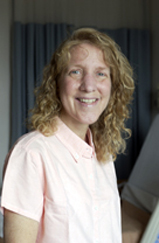 Name: Maureen Schultz Name: Maureen Schultz
Home State: Ohio
Since the early 1990s, Maureen Schultz has been participating in medical research at the NIH Clinical Center that focuses on a rare disease known as Job’s syndrome.
Why? Maureen is receptive to testing new drugs or procedures because of the level of caring and expertise at the NIH Clinical Center. She realizes that participating in medical research at the center is helping both her and others with the disease.
Maureen's story:
Most of us coexist with billions of bacteria daily and are exposed to millions of fungal spores each year, which rarely cause problems. Sometimes bacterial or viral infections may cause illness, but invasive fungal infections are much less common, unless the immune system is suppressed. Job's syndrome is a rare genetic condition that makes Maureen highly susceptible to bacterial infections (particularly boils) and fungal infections on her skin and in her lungs. She is also susceptible to problems with her teeth, sinuses, and bones - including scoliosis and osteoporosis. Maureen, who is 36 years old, can break a rib fairly easily simply by swinging a golf club. She is lucky - those with more severe bone damage can break a leg just carrying the groceries. Like Maureen, patients with Job's disease battle one problem after another.
Job's syndrome is not easy to diagnose, but Maureen knew she had it from the age of 3, thanks to an informed immunologist at Rainbow Babies and Children's Hospital in Cleveland, Ohio. Maureen displayed all the cardinal signs of the disease, losing part of one lung to surgery when an abscess developed. Through high school and college, she did fairly well, but after college, she developed an infection that would not go away. Tired of feeling unwell, in 1994 she got in touch with physician-scientists John Gallin and Steve Holland at the National Institute of Allergy and Infectious Diseases (NIAID). Holland invited her to participate in first one, then several, studies of the disease.
"Job's syndrome is an absolutely remarkable disease," says Holland, who came to NIAID's clinical program in the early 1990s. He studies patients who get bacterial or fungal infections spontaneously to understand why they do, how to treat them, and from that information to define fundamental principles. "This is work that has gone on in one shape or another here for decades," he says. "What makes the NIAID approach to infectious disease distinct is the focus on host defense: If exposure to these organisms is relatively broad, but disease is relatively rare, the problem must be something about the host or the environment in which the host is being exposed."
Maureen has been studied and treated by Holland in collaboration with experts in other institutes and disciplines, including genetics, dermatology, neurology, dentistry, and ear, nose, and throat. Holland and collaborators at the National Human Genome Research Institute are seeking the gene that controls the disease. "There is one gene that controls bacterial susceptibility, fungal susceptibility, dental development, scoliosis, skin problems, and IgE - that's one heck of an important gene," says Holland.
Meanwhile, Holland and his staff help manage Maureen's care. One summer, while she was vacationing, she began coughing up blood. She paged Vickey Anderson, the nurse practitioner who runs Holland's clinical service, so that Anderson could advise the doctors in an Idaho emergency room about which symptoms to look for and which medications to give her. Maureen needed to be stable enough to travel to Bethesda. "Without the NIH, I don't know that I would be here today," says Schultz.
Read more stories
|